Living in Taiwan
I have been living in Taipei (臺北), the capital of Taiwan (台灣) from 2007 to 2009. If you plan a visit you can find my recommendations of gorgeous food or great places to visit.
Sometimes It Can Get a Little Windy
October 8th, 2007. This weekend I have experienced my first Typhoon. Actually, it turned out to be quite an unspectacular event. I just stayed at home and let the wind blow at my window, and the rain fall outside.
The next day, it was over and only some debris and a few uprooted trees remind me of this event. Unlike in Germany, the main train station has not been blown apart. From what I have heard there will be several Typhoons each year. This one was among the larger ones, but still not such an uncommon event.
Living in Taipei
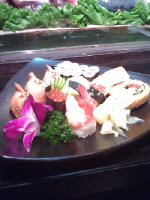 October 15th, 2007. People generally are very friendly and
helpful. And not always fluent in English. With some friendliness,
patience and sign language such barriers can usually be
overcome. Maybe I won't be able to teach Quantum Mechanics in
Chinese anytime soon. However, when it comes to shopping, getting
around and dining it is fine.
October 15th, 2007. People generally are very friendly and
helpful. And not always fluent in English. With some friendliness,
patience and sign language such barriers can usually be
overcome. Maybe I won't be able to teach Quantum Mechanics in
Chinese anytime soon. However, when it comes to shopping, getting
around and dining it is fine.
I finished most of my paperwork within the first week. Bureaucracy seems to be bearable, although I did notice that there are often different forms for foreigners and for locals; and that the former are usually simpler than the latter. Still, in order to be employed in Germany as a German I had to fill in more forms than as a foreigner in the USA. I feel really sorry for those poor foreigners coming to Germany.
I already found a couple of decent restaurants, supermarkets and also the post office. I even found a supermarket selling organic products (among others) from Germany. Close to the University there are also Mexican, Indian, Japanese, and various European restaurants. And, of course, lots of US chains like Starbuck's, McDonald's, KFC etc.
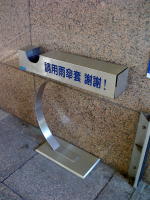 Garbage works slightly different from Europe or the US. Taipei
people have to buy dedicated garbage bags and bring them to garbage
trucks which drive at specific times to specific pick-up
spots. It's hard to miss those, they will always play some
Beethoven tunes which sound like somebody downloaded a bad late-90s
cell phone ringtone. Actually, there are also a couple of movies on
this topic on YouTube. It's amazing what you can find on the
Internet these days …
Garbage works slightly different from Europe or the US. Taipei
people have to buy dedicated garbage bags and bring them to garbage
trucks which drive at specific times to specific pick-up
spots. It's hard to miss those, they will always play some
Beethoven tunes which sound like somebody downloaded a bad late-90s
cell phone ringtone. Actually, there are also a couple of movies on
this topic on YouTube. It's amazing what you can find on the
Internet these days …
There also is a lot of rain in Taipei, so it is common for people to put their wet umbrellas outside a store. For those who still want to take it with them, one can find plastic bags that just fit umbrellas.
However, those come in different sizes, so sometimes I come across bags that are not large enough for my umbrella. Nonetheless, I found people here are very honest and so far my umbrella has not been stolen if I just leave it outside.
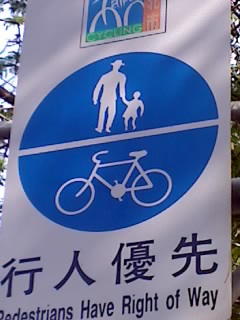
An unusual observation: the above street sign is quite common – it indicates that pedestrians have the right of way. However, did you notice that the German edition of this sign is slightly different? It has a women leading the child by the hand instead of a man!
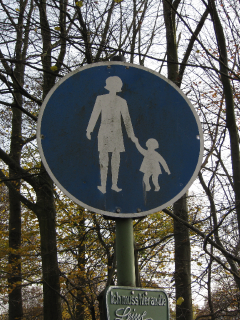
Interesting, huh?
Public Transport in Taipei – Pleasant Experiences
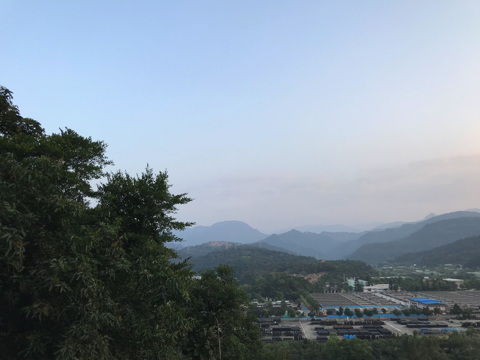 November 1st, 2007. The subway is called MRT or 捷運 (Jieyun) in
Chinese. It has been built only very recently earlier this
millennium. It fast, clean and reliable. It takes no more than half
an hour to travel through this city and even if I miss one train, the
next will be there within five minutes. The announcements are in four
languages — Mandarin, Taiwanese, English and Hakka. One notable
difference from other subway systems is that it is not allowed to eat
or drink on the trains and inside the stations. These rules are
emphasized using very funny cartoons inside the trains. Although the
cartoons are in Chinese only, they manage to bring the message across.
November 1st, 2007. The subway is called MRT or 捷運 (Jieyun) in
Chinese. It has been built only very recently earlier this
millennium. It fast, clean and reliable. It takes no more than half
an hour to travel through this city and even if I miss one train, the
next will be there within five minutes. The announcements are in four
languages — Mandarin, Taiwanese, English and Hakka. One notable
difference from other subway systems is that it is not allowed to eat
or drink on the trains and inside the stations. These rules are
emphasized using very funny cartoons inside the trains. Although the
cartoons are in Chinese only, they manage to bring the message across.
 I found the most convenient way to get around is by using an
"easy-card". You just hold it in front of a small plate in
the buses or at the MRT stations and the payment is automatically
deducted.
I found the most convenient way to get around is by using an
"easy-card". You just hold it in front of a small plate in
the buses or at the MRT stations and the payment is automatically
deducted.
At the bus stations, you have to wave to indicate to the driver that you want to board the bus. Usually, each station services several buses, so the driver would otherwise have no way of knowing which bus you want to travel on. On the bus, you have to pay either when you enter or when you exit. This is indicated by the Chinese symbols for 上 (Shang) (pay when you enter) or 下 (Xia) (pay when you exit). If you take a very long ride, it may be that the driver switches from one system to the other on certain spots, so you may have to pay both times. Unfortunately, the opposite does not happen — you cannot get a free ride.
Actually, it is pretty easy, my explanation just sounds a little more complicated than it is. Don't worry!
Hiking Trip to Yangmingshan
 November 25th, 2007. Inspired by the sunny weather I decided to go
hiking today. Already the bus trip was quite exciting. Starting from
Shilin — which in my opinion is a lovely place and looks greener
and friendlier than downtown Taipei — you really have a great
view when you drive up the mountain.
November 25th, 2007. Inspired by the sunny weather I decided to go
hiking today. Already the bus trip was quite exciting. Starting from
Shilin — which in my opinion is a lovely place and looks greener
and friendlier than downtown Taipei — you really have a great
view when you drive up the mountain.
Up at Yangmingshan I went for the 2 1/4-kilometer hike up to Qisinshan. Well, the path turned out to be quite steep. So the first 1 1/2 kilometers were quite exhausting. Nonetheless, while it felt better the higher I got, the weather got worse. At the peak there was just a lot of wind and rain from all directions and not much to see.
So while I still enjoyed the hiking tour, I was quite soaked when I came back. Fortunately, my spare sweater did not get too wet in my backpack. Although I am not really taking hiking tours that often, I still learned that having a spare shirt and sweater with me on a hiking tour is always a very good idea.
This was actually my first time up in the mountains in Taiwan. Since it seems to be a good area for hiking I think I will return sometime soon. Preferably, if the weather is a little better.
The Taipei Zoo
April 6th, 2008. Feeling bored on the weekend? (In Taipei? No way!) Looking for interesting places to go out? (In Taipei? Easy!) The weather is fine? Why don't you check out the Taipei zoo?
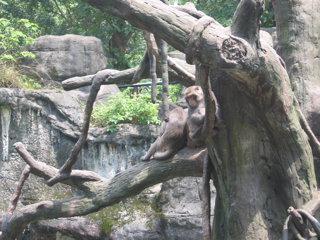
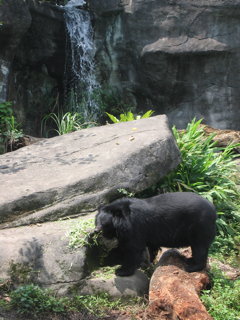
River Trekking
July 26th, 2008. A popular sport on weekends in Taiwan is river trekking (溯溪). You dress in a diving suit, get in a river and make your way upstream. Some parts are easier, others are harder. It is usually as much a social event as it is a sport. There are different spots with different challenges, but one of them is usually some kind of cliff diving. It looks scary, but that makes it only more exciting. Here are three photos with highlights of the tour I took.
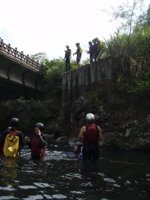
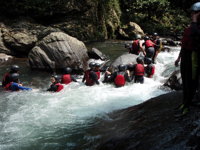
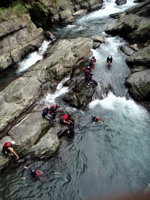
Yushan, the Tallest Mountain in Taiwan
April 4th, 2009. How far is four kilometers? Depending on where you are and where you want to go four kilometers can be quite far!
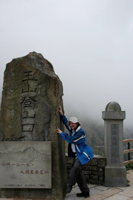 In Spring 2009 I joined a hiking tour to Yushan (玉山). Yushan is the
tallest mountain on the Island of Taiwan — 3952 meters! The
tallest mountain in Germany is merely 2962 meters high; although
Germany as a country is ten times bigger! Previously, I had only been
as far as 2600 meters above sea level for skiing in the Swiss
mountains. The climate in Taiwan is substantially more humid and at
the top of the mountain we can expect a chilly wind — it
certainly did not sound like an easy trip!
In Spring 2009 I joined a hiking tour to Yushan (玉山). Yushan is the
tallest mountain on the Island of Taiwan — 3952 meters! The
tallest mountain in Germany is merely 2962 meters high; although
Germany as a country is ten times bigger! Previously, I had only been
as far as 2600 meters above sea level for skiing in the Swiss
mountains. The climate in Taiwan is substantially more humid and at
the top of the mountain we can expect a chilly wind — it
certainly did not sound like an easy trip!
Still, I accepted the challenge. At the introductory event we saw acutely impressive pictures of the scenery and also listened to important security and safety precautions. Well, for me, it was just “listening” – since the event was entirely in Chinese and I didn't understand much. But I still enjoyed the pictures.
We first went on a practice hiking tour to Taoyuan valley (桃源谷). Taoyuan valley is near the Northeastern border of Taiwan and extremely beautiful in Spring. The tour was exciting and interesting; still, after six hours we were all very tired. On Yushan we will be hiking for two days with heavy luggage on our back. We will be in greater altitude, exposed to a chilly wind and cut off from civilization!
At last, the big day came. We entered the National Park; the entrance lies at a height of two kilometers above sea level. Now we had to climb for two kilometers!
We passed a couple of sights, among them a restroom up in the mountains which allegedly cost many thousands of dollars to build! We also passed a place called Dr. Monroe's resting place. It was named after an American administrator who fell to death from a cliff near that point. I did not find it an exciting prospect to have a cliff named after you just because you fall to death. Fortunately, I managed to be careful and there will not be another cliff named after “Dr. Schroers”.
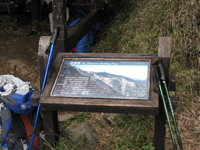

We continued our journey on a narrow path, steep cliffs on one side, and the mountain on the other. As time passed, it got more and more foggy, our vision got worse and worse. At last, in the evening we arrived at a small log home where we could get some food and spend the night. Certainly, all of us were truly exhausted and tired. Still, we did not rest for too long — at about 4:00 AM that night we got up and got on the road to the very top, the final 600 m still ahead of us. 600 meters can be quite a long way!
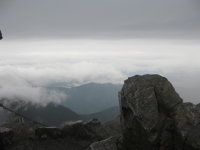
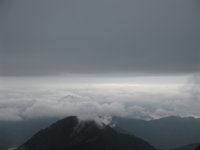
Part of the road no longer existed, and we climbed up a steep mountainside. In some places there was a chain to support us, but at other places it was broken. We could also see a sea of clouds which the Chinese call “Yunhai” (雲海). At last, we made it! We were all drained, but at last we had reached the top!
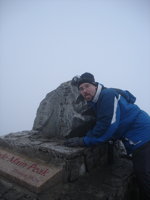
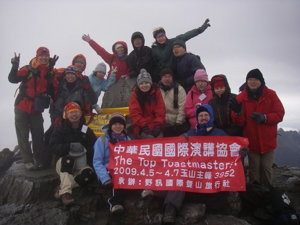
It was a remarkable and memorable trip, and I can recommend it to anybody who visits Taiwan. Granted, it is a little difficult to time it precisely – you need permission to enter the National Park, you need appropriate weather, and you need a group to join. If you get the chance, you should not miss it under any circumstances!
MRT Signs
May 24th, 2009. The city of Kaohsiung (高雄) got their own metro system only recently in March 2008. It is in excellent condition, fast and reliable. Just like in Taipei it is a pleasure to use!

Sometimes, however, I wonder if they are not a little too verbose in their communication with their customers. The above sign says “When approaching the elevator, reduce your speed to avoid colliding with elevator doors or other passengers”. It is written both in English and in Mandarin; in order to read it you certainly have to reduce your speed, get close enough to the door to read the tiny script and spend some time to digest it. I really wonder how many accidents this sign has helped to prevent.

This sign contains a warning not to smoke (written large enough for everybody to see), a warning not to use the elevator in case of fire (written slightly smaller), and a 5-step (!) detailed instruction manual in English and Mandarin for how to operate the elevator. Just in case you didn't know.
Southern Taiwan
May 25th, 2009. The southern part of Taiwan is considered to be even hotter and more humid during Summer than Taipei. I have found no evidence to falsify this claim. However, it feels also more calm, quiet and relaxed.
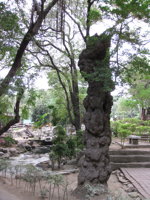 In Tainan (臺南) a visitor will find several calm spots in one of the
numerous temples around the city; it really feels less rushed –
both on the way to get there and once you are inside.
In Tainan (臺南) a visitor will find several calm spots in one of the
numerous temples around the city; it really feels less rushed –
both on the way to get there and once you are inside.
The city of Kaohsiung (高雄) feels more industrial, but I also found people to be very open and friendly. In Taipei, I was not used to getting greeted on the street as a foreigner, in Kaohsiung this is quite a common occurrence. Kaohsiung also has a beach, although I did not find it as beautiful as other places (but I openly admit that I am biased and only visited it for one day). One could also see an abundance of container ships in the distance.
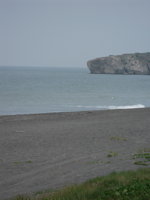
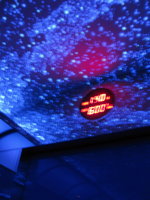

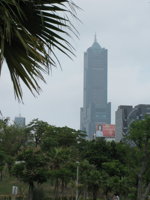
One highlight (in the literal sense) of any visit to Kaohsiung is the tallest building in town, the Tuntex Sky Tower.
When taking the elevator to the top, I felt reminded of the same design as in the Taipei 101; however, since the 101 is newer, the original definitely originated in Kaohsiung and was only subsequently imported to Taipei.
Fertilized Egg – A Vietnamese Specialty
 June 7th, 2009. There is a specialty which allegedly is quite popular
both in Vietnam and in the Philippines. Fertilized eggs — just
like your normal eggs, except that they got fertilized, and you wait a
little before you boil them. My Philippine colleague told me that he
never managed to bring himself to try one, but he knows of other
people who really love them.
June 7th, 2009. There is a specialty which allegedly is quite popular
both in Vietnam and in the Philippines. Fertilized eggs — just
like your normal eggs, except that they got fertilized, and you wait a
little before you boil them. My Philippine colleague told me that he
never managed to bring himself to try one, but he knows of other
people who really love them.
I have eaten it a few times already. It seems that there is some variation in the development of the fetus. Sometimes, you can feel that some bones have already developed, while other times there are none.
All in all, it is edible, and I can recommend everybody to try it at least once. Bring a couple of friends that can support it each other if you need to. Remember, what my Japanese colleague told me — it is the same material, just rearranged slightly differently.
Taiwanese Specialties
July 21st, 2009. You don’t need to seek out Vietnamese places for food, though. Here I want to introduce favorite two yummy Taiwanese desserts.
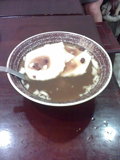
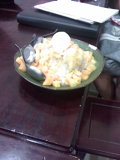
The first one is called Douhua (豆花). It is a mixture of soft tofu with red beans or similar, sweet toppings; it can be served either hot or cold. Personally, I prefer hot, even in Summer. The reason is that having something cold in Summer is not going to help your body digest it easier – in fact, your body needs to expend energy in order to heat up cold food, thereby making you sweat even more. With hot food your body needs to also expend energy to cool you down. So at the end of the day it doesn’t really matter, just don't think that you will sweat less from having cold drinks rather than hot drinks in Summer!
The second dessert is ice 冰淇淋. Unlike Italian or Swiss-style ice cream, this one is not sweat on its own. In fact, it is plain iced water. What makes it sweat are the other ingredients, like either red beans, green beans or other toppings. For obvious reasons, you can only get this one cold, not hot!
Some people have reminded me that I should also mention the infamous stinky Tofu called Choudofu 臭豆腐. Well, this entry is more about desserts, so … okay, okay, I should be honest: I haven't even tried it. So I don't think I should include a picture and comments in here. I know it is unfair; after all, I am eating Harzer cheese which is certainly unpleasant on the nose, too. Still, I think I will only include it here when I have actually tried it (which means I should stop making excuses on my next visit to Taiwan).